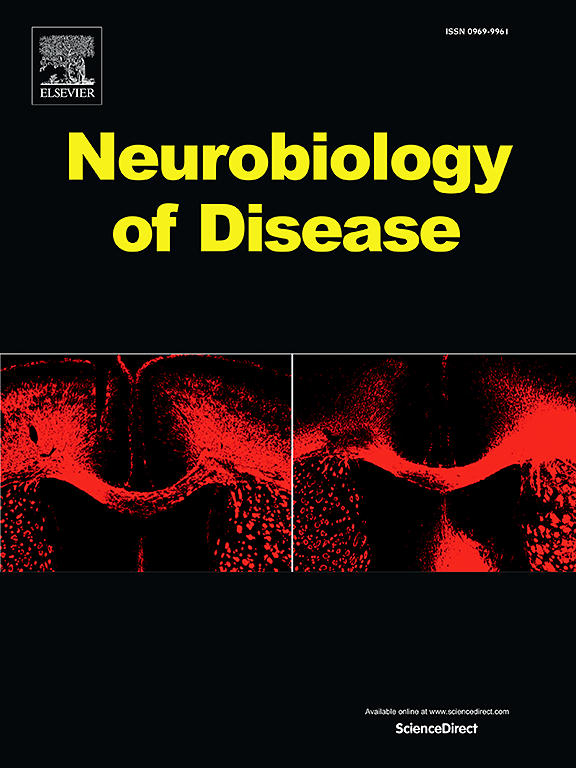匹克病中tau聚集物的分子多态性。
IF 5.6
2区 医学
Q1 NEUROSCIENCES
引用次数: 0
摘要
背景:在许多神经退行性疾病中,Tau蛋白是进行性神经病理改变的核心。虽然已经研究了tau病理通过神经网络传播的轨迹,但驱动疾病的分子过程尚不清楚。表征这些过程需要成像工具来补充神经病理学检查与病变的分子组织信息,同时保留其解剖位置的细节。高分辨率冷冻电子显微镜研究需要隔离材料,这破坏了病变结构随位置变化的信息。免疫组织化学鉴定病变的主要成分,但提供的分子组织信息很少。为了弥补这一知识差距,我们开发了先进的生物物理成像工具来原位探测患病脑组织中单个病变的分子组织和组成。在这里,我们描述了他们的使用,以评估纤维组织和元素组成的变化,在大脑中含有tau病变的79岁男性痴呆症。方法:采用原位微x射线衍射(μXRD)测定tau在单个病变中的聚集状态,并用微x射线荧光(μXRF)测定病变中的元素含量。由此产生的信息与一系列切片的免疫组织化学相结合,证实了病变的主要分子成分,并将结果置于更广泛的解剖学背景下。结果:神经病理学检查显示海马结构中有典型形式的tau包涵体,包括齿状回中广泛的Pick小体。μXRD数据表明,颗粒层的Pick小体中纤维含量相对较低,而在CA4和门区相邻的神经细胞中,显微镜下弥散的tau表现出更大的纤维信号密度。μXRF数据显示,在几乎所有含tau的病变中,相对于周围组织,锌、钙和磷的水平都有所升高。在纤维含量高的地区,硫沉积更明显。匹克氏病的第二个病例显示了类似的结果。结论:这些观察结果表明,病变形态与解剖定位、tau纤维的程度和金属的不同积累有关,并表明含有不同水平tau纤维的病变具有不同的生化微环境。本文章由计算机程序翻译,如有差异,请以英文原文为准。
Molecular polymorphism of tau aggregates in Pick's disease
Background
Tau protein is central to progressive neuropathological changes in many neurodegenerative diseases. Although the trajectory by which tau pathology spreads through neural networks has been studied, the molecular processes that drive disease are unknown. Characterizing these processes requires imaging tools that supplement neuropathological examination with information about the molecular organization of lesions while preserving details of their anatomical location. High-resolution cryo-electron microscope studies require isolation of material which destroys information on variation of lesion structure with location. Immunohistochemistry identifies principal constituents of lesions but provides little information about molecular organization. To bridge this knowledge gap, we have developed advanced biophysical imaging tools to probe, in situ, the molecular organization and composition of individual lesions within diseased brain tissue. Here we describe their use to assess the fibrillar organization and variation of elemental composition in tau-containing lesions within the brain of a 66-year-old male with dementia.
Methods
We used in situ micro X-ray diffraction (μXRD) to determine the aggregation state of tau in individual lesions and micro-X-ray fluorescence (μXRF) to determine the elemental content of these lesions. The information thus generated was combined with immunohistochemistry of serial sections that confirmed the principal molecular constituents of lesions and placed the results in a broader anatomical context.
Results
Neuropathological examination revealed classical forms of tau inclusions in the hippocampal formation including extensive Pick bodies in the dentate gyrus. μXRD data indicate that Pick bodies of the granular layer are relatively low in fibril content, whereas, surprisingly, the microscopically diffuse tau in the neuropil in adjacent CA4 and hilus regions exhibit far greater density of fibrillar signal. μXRF data show elevated levels of zinc, calcium and phosphorous relative to surrounding tissue in essentially all tau-containing lesions. Sulfur deposition appeared greater in areas exhibiting high fibrillar content. A second case of Pick's disease showed analogous results.
Conclusions
These observations demonstrate a correlation of lesion morphology with anatomical localization, degree of tau fibrillation and differential accumulation of metals and suggest that lesions containing different levels of tau fibrils harbor biochemically distinct microenvironments.
求助全文
通过发布文献求助,成功后即可免费获取论文全文。
去求助
来源期刊

Neurobiology of Disease
医学-神经科学
CiteScore
11.20
自引率
3.30%
发文量
270
审稿时长
76 days
期刊介绍:
Neurobiology of Disease is a major international journal at the interface between basic and clinical neuroscience. The journal provides a forum for the publication of top quality research papers on: molecular and cellular definitions of disease mechanisms, the neural systems and underpinning behavioral disorders, the genetics of inherited neurological and psychiatric diseases, nervous system aging, and findings relevant to the development of new therapies.
 求助内容:
求助内容: 应助结果提醒方式:
应助结果提醒方式:


